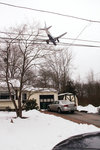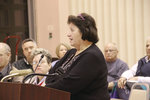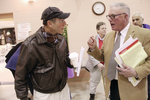By JOHN HOWELL -- Lowell Lisker likes running on the Pilgrim track. It's easier on his knees than the pavement. But while his knees may be getting a break, are the fumes from overhead jets landing and taking off at Green Airport a health risk?
This item is available in full to subscribers.
We have recently launched a new and improved website. To continue reading, you will need to either log into your subscriber account, or purchase a new subscription.
If you are a current print subscriber, you can set up a free website account by clicking here.
Otherwise, click here to view your options for subscribing.
Please log in to continue |
|



Lowell Lisker likes running on the Pilgrim track. It’s easier on his knees than the pavement. But while his knees may be getting a break, are the fumes from overhead jets landing and taking off at Green Airport a health risk? Would wearing a mask reduce the risk of inhaling ultrafine particles?
That was one of the last questions asked of Dr. Michael Byrns Thursday evening at an informational meeting conducted by the state Department of Health and the Department of Environmental Management on the 2018 Green Airport air quality report. Rep. Joseph McNamara and Senator Michael McCaffrey hosted the meeting at the Pilgrim Senior Center.
So, what about a mask?
Byrns, environmental health risk assessment toxicologist with DOH, questioned what type of mask. When Lisker told him a fabric mask on an elastic, he said while effective on particles it wouldn’t stop the ultrafine particles that are smaller than 0.1 microns. To catch those Lisker would need a respirator, which Byrns added would restrict his air intake. Lisker is not going to get a respirator.
Janice Pangman, who recently made the final payment on her 30-year mortgage on her house on Rowe Avenue, isn’t thinking about masks. She wants out of the neighborhood and she believes the kids playing at the Winslow Park fields should get out, too. She said the soot from aircraft exhaust streak her house and roof, that the unimpeded wind from across the airfield has blown down fences and even bent metal fence posts and that she has to endure the roar of jet engines.
“I can’t go out in my backyard,” she said. “Those children don’t belong there [Winslow Park]; my house doesn’t belong there…I don’t understand it.”
The air quality report reflects data gathered from four monitoring stations around the airport on a continuous basis taking into consideration winds and temperatures. Under legislation approved in 2008 the state started measuring air pollutants at the airport. That measure was extended in 2017 at which time the number of pollutants measured was lowered to ultrafine particles and black carbon. The monitors are operated by the Rhode Island Airport Corporation and the data interpreted by the Department of Health and Department of Environmental Management.
In opening remarks, McNamara said requirements to monitor the air quality near the airport expire this July and that he and McCaffrey have introduced legislation to extend monitoring for another two years. He credited Warwick residents Michael Zarum and Michele Komar with raising concerns over air pollution caused by the airport and its effect on neighborhoods. He said Rhode Island is one of the first states to monitor ultrafine particles.
Generally, higher levels of pollution can be correlated to wind direction and force as well as aircraft operations. Concentrations of ultrafine particles are comparable to conditions near Route 95 and in downtown Providence, said Byrns. The state is also monitoring air in Providence and East Providence.
Byrns said strides have been made in cleaning up black carbon. Further, as noted in the report, because black carbon monitors are very sensitive and pick up operational factors such as air conditioners, cycling in monitor shelters they “are not currently collecting useful data.”
However, since the report was released Joseph Wendelken, public affairs officer for the Department of Health said in an email said last week that black carbon monitoring has commenced as recommended at the airport.
“Black carbon is now being monitored at the airport,” he said. “There were some challenges with instrumentation earlier on, but the Rhode Island Department of Health [RIDOH]’s State Health Laboratories were able to help address those issues.”
What of ultrafine particles?
Byrns said there are no EPA standards on ultrafine particles and “the science is not understood.”
The report says that, according to the EPA, there is “suggestive but limited evidence that short-term UFP exposures are linked to respiratory and cardiovascular health effects.”
The report goes on to say, “Due to their very small size, UFPs when inhaled can travel deep into the respiratory track and pass across membranes in the body that would block the movement of larger particles.”
What is the effect?
The report refers to a 2015 study by the California EPA that demonstrated a long-term exposure to UFPs contributes to heart disease mortality. The report goes on to say “certain constituents of UFPs including cooper, iron, other metal and elemental carbon [soot] were strongly associated with death from heart attacks.”
Byrns compared the readings to those in Providence and East Providence, observing that levels of pollutants are particularly high on Route 95 during the morning commute hours.
“Are you saying there’s nothing to be worried about?” asked Alfred Guertin who lives on Lydick Avenue and in the flight path that takes aircraft over Pilgrim High. “Am I not any better than an interstate?”
Byrns said the level of UFPs at the Lydick monitor are similar to downtown Providence.
“I’m not saying it’s good,” he said.
In an email Wendelken said, “There are no data that suggest that T.F. Green is affecting the health of people who live near the airport. The report recommends the gathering of slightly different data, as opposed to just ‘more data.’”
Guertin said he has “black rails” on his roof from aircraft exhaust, asking “what is the airport going to do about it?” Soot from exhaust was raised by others, including Ward 6 Councilwoman Donna Travis who also mentioned “film” on swimming pools from aircraft soot.
The report’s recommendation that the Pembroke monitor (which was relocated from Pembroke to Rowe Avenue) be relocated closer to the Winslow Park playing fields, which is also closer to the runway but further away from the residential neighborhood, was questioned. The stated purpose of the site is that it “more accurately reflects the impact of the airport on children in that area.” Guertin questioned the benefit of the relocation, suggesting that a monitor further away from the airport – he mentioned Rocky Point – would provide a comparative reading.
Ward 2 Councilman Jeremy Rix suggested that rather than moving one of the monitoring sites, a fifth be opened.
Ward 3 Councilman Timothy Howe, who lives near Runway 34 at the east side of the airport, asked whether it was safe when he could smell the jet fumes. Byrns didn’t have a conclusive answer, but he was in agreement with Howe’s observation that trees and the natural habitat serve as a barrier to air carried pollution. Howe observed that the playing fields are open to the airport.
“It’s been two years [since the fields were opened] and we’re still waiting for the trees to be planted,” he said.
In response to questions from Zarum, Christine Vitt, RIAC senior vice president and chief infrastructure office, estimated RIAC has paid $3.4 million over 11 years to build and operate the four air quality monitoring stations. Zarum said RIAC has not had a “good history” of interacting with its neighbors, pointing out that at one time the public had a role on an advisory committee and why wasn’t that input followed?
“Her [Pangman’s] house should have been bought out…will you look at that going forward?” he asked.
According to a closing slide in the DOH presentation, the next steps to this program are to determine whether there should be a Public Advisory Committee; where to place monitors; how to best monitor the runway extension and to assess long-term goals of the program to collect data to provide a good understanding of ultrafine levels and at least a year of black carbon data and data southeast of the airport.
Editor's note: This story has been updated to correct the spelling of Lowell Lisker's last name.
7 comments on this item Please log in to comment by clicking here
richardcorrente
If the City Council wants unbiased, impartial data about the pollution at the airport, I suggest they receive it from a neutral third-party testing company, NOT the RIAR. . The monitors being used today are "operated by the Rhode Island Airport Corporation". They have a very strong incentive to produce numbers that will save the airport millions. Not an unbiased test in my opinion.
Here's my observation. I have an office with 2 potted plants of artificial flowers outside. For twenty years those pots sat outside my East Greenwich office and stayed clean. Now those same 2 pots are outside my office in Hoxie where they became covered with soot in the first 3 months. I replaced all the flowers before Christmas and today, they're covered in soot again. (4 months) That unscientific test shows me more than any test done by the airport people.
Happy St. Patricls everyone
Rick Corrente
The Taxpayers Mayor
Tuesday, March 5, 2019 Report this
Justanidiot
sew master mayer, yer orafice in eastern greenwithc was located next to the busiest intersection in the state, had a major store next dore that gots all kinds of deliveries, and was in a parking lot of many many many popular destinations. eyes luv yer science. maybes youse can explain climate change and evolutions to us
Tuesday, March 5, 2019 Report this
Cat2222
Compelling detailed analysis of the situation that will sway even the most ardent detractor.
Tuesday, March 5, 2019 Report this
richardcorrente
Dear Justanidiot,
You ask me to explain climate change and evolution. I'm honored that you ask.
"Climate change" has the tenancy to change from time to time depending on...the climate at that particular time.
Evolution evolves in a similar but different fashion.
I hope that clears up both of these issues old friend.
Happy St. Patricks Justanidiot.
Happy St. Patricks everyone.
Rick Corrente
The Taxpayers Mayor
Tuesday, March 5, 2019 Report this
Justanidiot
is youse lookng at these scientifical tings from an antrhopormorphical or zootropormorical bias?
asking for a friend
Wednesday, March 6, 2019 Report this
richardcorrente
Dear Justanidiot,
Of course, to be perfectly fair, I am looking at it from both sides.
How unfair would it be if I didn't?
Thank your friend for me. He/she is very intuitive.
Happy St. Patricks old friend.
Happy St. Patricks everyone.
Rick Corrente
The Taxpayers Mayor
Thursday, March 7, 2019 Report this
KeepCalmandCarryOn
Of course the air quality has gone down, I smell it every Morning in my neck of buttonwoods.
I work in construction, testing is never done by the Owner but by a third party testing firm.
This expansion was jammed down our throats (under Avedesian) with little public input! And the environmental impact studies were poorly done. The expansion has done nothing economically for the city!
I'm lucky that these planes don't always fly directly over my house but they do fly over. Warwick needs to get on the ball with this issue and many others!!
Sunday, March 10, 2019 Report this